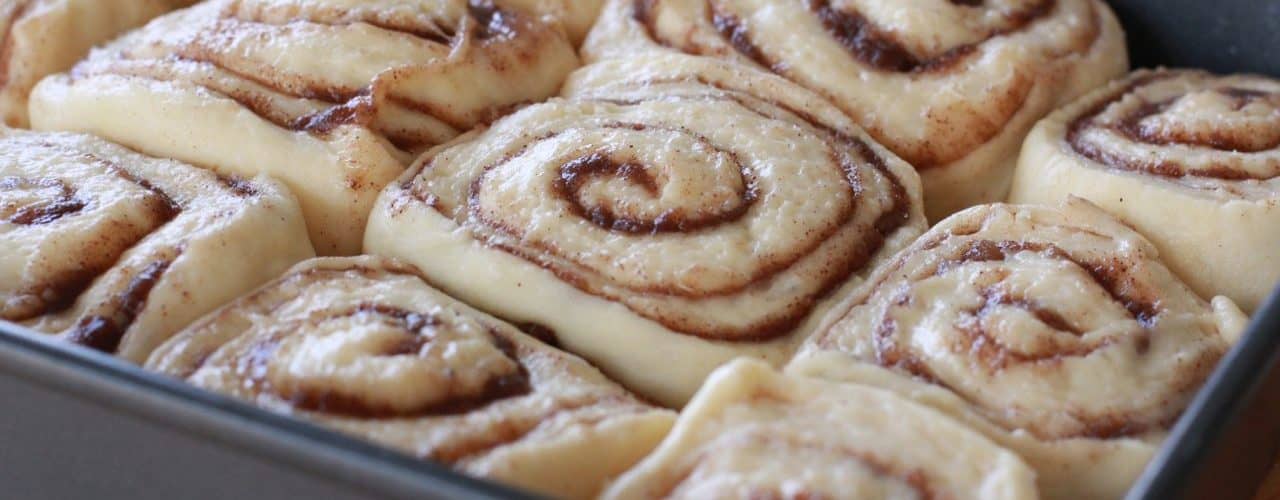Hot, sweet, melty cinnamon rolls. Just thinking about them makes your mouth water! You can buy them already made, frozen or prepackaged in the supermarket. Or you can head to the mall and follow your nose to one of a chain of commercial bakeries. Better still, you can make your own. In addition to choosing the size and quantity of your cinnamon rolls, making them at home gives you the opportunity to add extra ingredients to make them even more yummy. An extra bonus? While the cinnamon rolls are baking, your home will smell yummy too.
Take Your Time
Homemade cinnamon rolls are not on anybody’s list of “thirty-minute meals.” The difference between light and airy cinnamon rolls and lumps of dough that can substitute for doorstops comes down to technique. Experienced bakers know that it’s always best to have everything they need in front of them at room temperature before they begin to mix ingredients. If this is your first time making dough, read the recipe’s directions carefully and then read them again. Allow yourself enough time for the dough to rise which can take up to two hours, but you don’t have to watch the dough while the yeast is doing its work. After mixing your ingredients, cover the dough with a clean towel and then go do a couple of loads of laundry or watch a movie. Or, run out and buy a rolling pin if you don’t already have one.
Ingredients
Cinnamon rolls are basically made from dough, cinnamon, sugar and butter. How you put all those ingredients together is what makes the magic happen. Dough-making can take a little bit of practice at first, but once you get the feel of it, you’ll be whipping up perfect batches of homemade cinnamon rolls whenever you have a craving. You’ll need flour, milk, salt and yeast. Some dough recipes also require eggs or baking powder. Yeast is what makes the dough rise and gives your cinnamon rolls a lighter texture, but it must first be dissolved in warm water, then added to a flour and sugar mixture. Follow the package directions carefully.
The Basics
Once the dough rises, you’ll need to punch it down to release the air. Some recipes require the dough to be kneaded for a certain amount of time before rolling it out. Roll the dough into a ball on a floured surface and then roll it out into a rectangle as recommended by your recipe. Once it’s rolled out to the desired size and thickness, add the cinnamon and sugar mixture as well as the recommended amount of softened butter. Here’s where you get to add in your extras as well, such as raisins or chopped nuts. When the filling is evenly distributed on the dough, starting from one long end, carefully begin rolling the dough tightly away from you until you have one long roll. Pinch the ends to seal, and with a sharp knife, begin cutting the roll into pieces of about one inch. Place the rolls onto a greased baking pan close together but not quite touching. Lightly cover the pan with a towel or plastic wrap and allow the dough to rise again for at least 30 minutes. Place the cinnamon rolls in a preheated oven and in a short while, your kitchen will smell like a little bit of heaven. The rolls will usually be ready to come out of the oven in about 20 minutes.
The Big Finish
Make the glaze for the cinnamon rolls while they are baking in the oven. A simple glaze can be made from confectioner’s sugar, vanilla and a little milk but be creative if you like by adding in maple or some other flavoring. The glaze should be pourable so that it will flow over the pan of rolls slightly seeping into them. Be sure to give the cinnamon rolls 5 or 10 minutes to cool so that the glaze will coat the rolls. If the rolls are too hot, the glaze will not only seep down into the rolls but will also sink to the bottom of the pan. If the rolls are too cool, the glaze may not adhere as well, and isn’t the ooey-gooey-ness of the glaze part of the pleasure of eating cinnamon rolls?
References:
Food Network: Paula Deen’s Cinnamon Rolls Recipe
The Pioneer Woman: Cinnamon Rolls 101
Betty Crocker: Cinnamon Rolls



